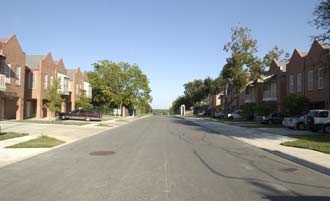The Spurs' success hasn't helped the neighborhood near the SBC Center
In the three years since the SBC Center was built on East Houston Street, it has been home to two NBA championships, three rodeos, and countless other special events. Despite the successes inside, the nearby East Side neighborhood hasn't seen any substantial development outside the walls of the 18,793-seat arena.
Initially, the SBC Center appeared to be a coup for District 2. Instead, the East Side community's visions of the arena attracting retail, business, and entertainment centers have failed to materialize.
| The Springview housing development lies one block south of the SBC Center, but there are no retail or commercial complexes to economically invigorate the neighborhood. (Photos by Mark Greenberg) |
Terri Williams, vice chair of the Arena Steering Committee, which aims to see the area near the SBC Center flourish, says, "Arenas are always sold on the benefit they will bring to the community. In San Antonio, around the SBC Center, we have spot projects, but that's not enough. You can't wait; you must be a catalyst."
The Community Economic Revitalization Agency, Bexar County officials, and the Spurs organization have commissioned a study to determine the types of development the area can support. Also, in late June, Bexar County Commissioners issued a request for proposals for a Community Arena Complex Master Plan.
Priorities for the area include building businesses that would attract SBC Center patrons before and after events, increasing the number of bookings at Freeman Coliseum, and finding uses for the warehouses south of the arena.
However, Williams notes that previous studies, such as an April 2003 analysis conducted by the Economic Revitalization Associates, found that the area needed better streets and sidewalks, marketing improvements, and commercial and residential real estate.
"It's seems like I've seen this all before," Williams says. "We need a plan, a timetable that we can look at and see that things are getting done. "It also takes risks from developers. They want to see a return on their investment and if they don't see the income level that they look for, they bolt. We need to change that perception."
District 2 Councilwoman Sheila McNeil was unavailable for comment, but, like Williams, McNeil has stated her commitment to ensuring that there is progress in development around the SBC Center and Freeman Coliseum.
"The arena is good for the city as a whole; however, it is not particularly good for the immediate neighborhood," says Ramiro Cavazos, the City's director of economic development. "What I would like to see is improvements to St. Philip's College, and better-paying jobs, not just the retail and entertainment aspect of development."
But retail expansion is top priority with Chris Young, the City's director of development operations, who says development near the arena has "to be relevant." Young cited Best Tickets, a re-seller located across the street from the arena, as an example of a benefit to the area.
Reverend D.W. Brooks, owner of Brooks Funeral Home and longtime East Side resident says he has nothing against the Spurs, "but I do with the City."
"Construction of the arena was terrible for businesses, streets were torn up, and when we tried to contact the construction companies they were very rude and uncooperative. The only benefit I've seen is that my taxes have doubled and my employees park cars during events."
When the SBC Center was still a blueprint, its construction was planned for an abandoned rock quarry in Northeast San Antonio. After that site was nixed, the focus moved to County-owned property on the East Side; the primary design of the arena remained while spin-off development of 500 acres of retail and commercial space was shelved. "Wow, we could have really used some of that over here," Brooks says. "The only place for arena visitors to go after games is probably Sunset Station, but I don't think that we see any real benefit."
Spurs Vice President of Operations Leo Gomez notes that his priority is to ensure the success of the building. "Spurs owner Peter Holt was very careful in not over-promising the residents. He let them know that the SBC Center is not a savior," says Gomez. "But if you look at it, we have done some very positive things. Look at the condition of the roads in the area. Look at how much they have improved. That wouldn't have happened had we not moved in."
Feasibility studies and good intentions haven't generated commercial interest in the arena neighborhood. "The challenge is not the SBC Center, it's what are we doing to market ourselves to developers," Cavazos says. "Growth is determined by the market and right now the market is not there."
Yet, Williams holds out hope that a progressive developer will see the neighborhood's promise. "I envision high-end neighborhoods, a place that will mirror the King William area," she says. "I want affordable, not low-income, housing and mass numbers of residents with disposable income. I think this can be achieved if someone is willing to go to bat for us." •
By Mario Ochoa


















